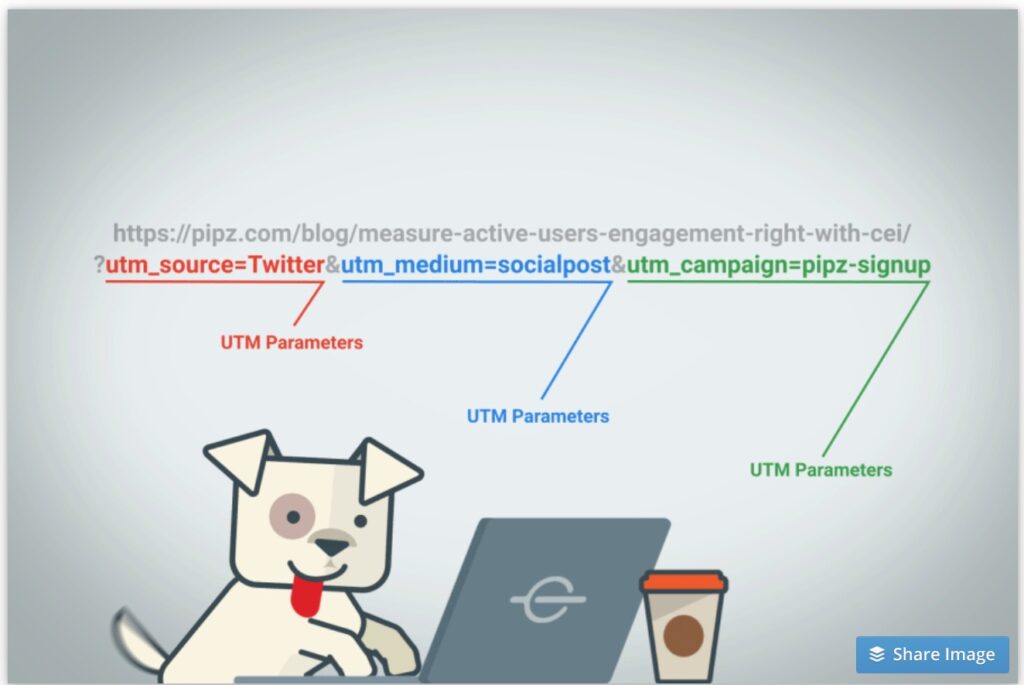Complete Guide to UTM Parameters: Get Better Conversions
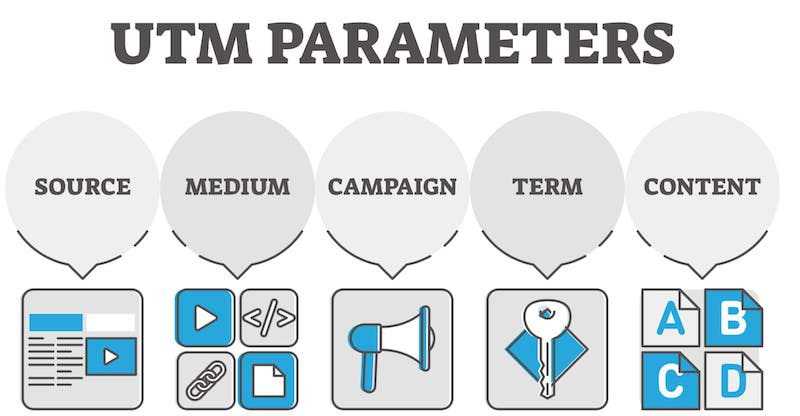
You are running a campaign on social media. You’ve solicited 20 of your close friends to promote your new Wiggie Doodle-1000. You don’t have to do much convincing to get them on board. They believe in your vision and want to see you succeed.
You make it super easy for them to promote your campaign. You give them links and images and copy they can share with their audience.
The link takes interested parties to a landing page that lays out all the cool benefits of Wiggie Doodle-1000.
Your sister Trina sends you 1,000 visitors while Robert sends you only 4 visitors.
You are static when you look at your traffic and see you had 1004 visitors. #success
But what you don’t see is which person’s efforts were more successful.
That difference equates to data essential to understand if you want to replicate, scale, or adjust your campaign.
As a CRO, you focus on conversions. But at the core of conversion attributions is traffic attribution. Without the right tools and strategy for measuring traffic, attributions can be tricky.
UTM parameters to the rescue.
Like testing and experimentation, UTM codes let you track the success of your marketing efforts. If you are serious about using tracking and measuring for growth and engagement, consider mastering and incorporating UTM parameters into your marketing program.
This article will layout:
- What are UTM parameters?
- Benefits of using UTM codes.
- How to set up UTM parameters in Google Analytics.
- How Google Analytics processes traffic sources
- UTM Parameters Best Practices
Let’s start with a few definitions and benefits…
What are UTM Parameters?
UTM is short for Urchin Tracking Module (in honor of the original creators, Urchin Software). Use UTM Codes to collect data about your traffic sources.
You can think of UTMs as a custom URL created for campaign tracking. They track attributes of the traffic that comes to your marketing and advertising campaigns.
Data is the cornerstone of all good marketing and testing programs. Which means you have to collect it properly. Using UTMs with web analytic tools allows you to segment data and understand how traffic flows to your site.
Take the Wiggie Doodle-1000 example. Say a visitor comes to your site four times before converting. Each time they come to the site they use a link from a different promoter.
Without UTM parameters used with Google Analytics, you wouldn’t be able to track such complexity. Which means you would have incomplete data regarding the source of your conversions or customer’s journey.
UTM parameters have five distinct elements. We will look at these shortly. But first, let’s look at the benefits of using UTM parameters.
Why Are UTM Parameters Important
As someone serious about growth and optimization, you must understand conversion attributions. At the heart of conversion attribution is traffic attribution. As stated earlier, with UTM parameters, you can get traffic attribution data unavailable without them.
That is one benefit. Here are a few more:
- What precise channels bring visitors to your websites? You can get a clear picture of which lead generation channels and referral traffic leads to conversions.
- Accurately compare performance across multiple channels.
- They help you understand your customer’s journey.
- You can calculate the true cost per acquisition.
- They help you track the value of specific campaigns and strategies.
- They help you track the value of specific campaigns and strategies.
- UTM can validate the performance of a specific channel through traffic attribution. For instance, if there is a debate about which social media platform you should use to promote campaigns, data collected via UTMs can give a clear picture of which channel you should devote time and resources to.
- You can use UTM parameters to A/B test content and messaging.
To get these benefits requires strategic planning.
Now that you understand how powerful UTM parameters are for your marketing, let’s look at how to use and create these information-loaded URLs.
The Five Elements of UTM Parameters
Let’s look at each element and see UTM parameters examples.
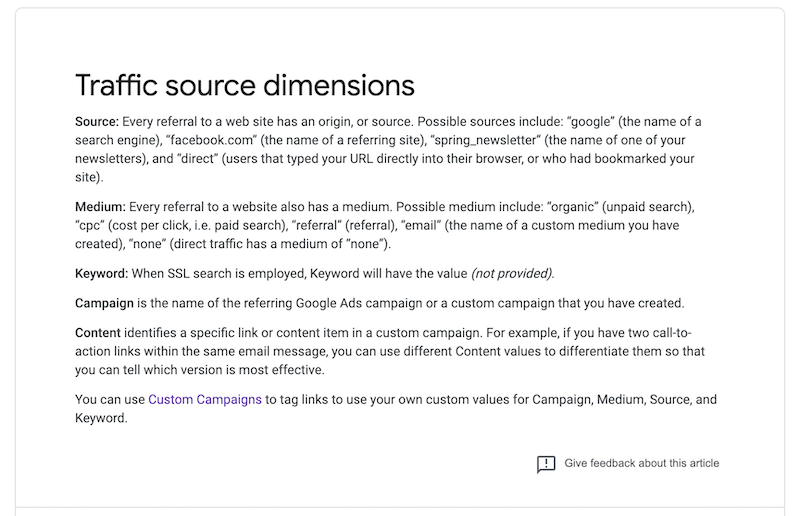
Element 1 – Campaign Source: utm_source
This value identifies the specific source (i.e., platform or tool) driving the traffic. It answers the question, “where the campaign is running.” For instance, Instagram, Google, Facebook, ActiveCampaign, etc.
Example Source: LinkedIn
UTM parameter: utm_source
Sample UTM Code: utm_source=LinkedIn
If you exclude this piece of code, consider your UTM parameter nonfunctional.
utm_source connects to the value of utm_medium. If utm_medium is missing, Google Analytics will ignore utm-source. Google Analytics will put this in their catch-all category – “Direct.”
Remember, Google Analytics can take source data from HTTP Referrer (we will discuss this later). However, in the presence of utm_source, it will overwrite the information from HTTP Referrer.
Element 2 – Campaign Medium: utm_medium
This tracks the channel used to bring traffic to your site. Examples include email/email newsletters, social media, paid social, etc.
Example Medium: organic_search
UTM parameter: utm_medium
Sample UTM Code: utm_medium=ConvertEmailNewsletter
Medium is a broad value that can be created by multiple channels. For example, the channel, email, can come from a variety of tools, like ActiveCampaign, Convertkit, HubSpot, etc.
Google uses the UTM_medium for its Default Channel Grouping. So, when possible, use a value like “email” instead of “list1”, or “social” vice “Facebook”.
It is also interesting to note that multiple mediums can come from a single source. For example, Google as a source can send you traffic from:
- Organic search
- Google Display Ad Network
- PPC
That’s three different mediums from one source.
See how source and medium are connected?
Alone, source and medium give you more information than HTTP Referrer (more on this header below), the other three campaign parameters fill in the missing blanks.
Element 3 – Campaign Name: utm_campaign
Technically, this is an optional value. However, omitting this value will return “not set” in Google Analytics. “Not set” offers no value to your analysis, so I encourage you to use it.
There are two conventions for naming the campaign element, tactical, or strategic. You can also use a combination of the two.
Let’s look at each…
Utm_campaign Tactical Naming Convention
This method is straightforward. Use a name that corresponds with your source/medium that makes it easy to track your campaign, goals, and stay organized.
For example, this could be your campaign name, product name, promotion id, on so on.
Example Campaign: free_trials_from_blog
UTM parameter: utm_campaign
Sample UTM Code: utm_campaign=free_trials_from_blog
Advantages of Using Tactical Naming Convention:
There are several benefits to this approach, including:
- This convention makes it easy to spot results for custom campaigns in Google Analytics.
- For ad campaigns, it’s easy to see the revenue.
- Creates naming consistency with Google Analytics UTM parameters and the tool or platform that’s being used. Campaign Name is the name used in your marketing tool.
- Comparing campaigns with a single source/medium becomes easier.
Disadvantages of Using Tactical Naming Convention:
However, there are a few disadvantages to this approach:
- If you share the campaign from an unnamed platform, your entry will be nameless.
- Sloppy naming. This causes chaos in Google Analytics Campaign reports.
- Unless filtered for single source/medium, unfiltered reports can be difficult to read.
If using this convention, it is important to create a universal naming system that works across teams.
Utm_campaign Strategic Naming Convention
With this convention, you take a more strategic route using values that identify the product, class of product, or event you’re promoting. You can map names to your overall marketing objectives.
This is helpful because it allows you to compare high-level marketing objectives like Christmas-2020 and New Product Launches against each other or different campaigns.
If you only use tactical internal naming, you could end up with 20 different campaigns for product launches. You could compare them to each other but would have difficulty comparing it to a broad campaign like Christmas-2020.
Example:
Example Campaign: Convert Experiences (Product Name)
UTM parameter: utm_campaign
Sample UTM Code: utm_campaign=Convert Experiences
Advantages of Using Strategic Naming Convention:
- Comparing results across different high-level campaigns is easy.
- You get cleaner reports than when using the tactical naming convention.
- Can see how your campaign performs for each of your traffic sources.
Disadvantages of Using Strategic Naming Convention:
- Tougher to compare data in Google Analytics to data gathered in other tools and platforms because names won’t correspond to each other.
- You will deal with entire marketing campaigns, i.e, promotion of Convert Experiences. This makes it difficult to break down individual efforts across the campaign.
- You must document the naming convention with precision and followed for full benefits and to prevent errors in naming.
Utm_campaign Hybrid Naming Convention
If you want the best of both worlds, consider using a hybrid naming convention.
Unfortunately, Google doesn’t have a direct solution for this. However, you can use Campaign Grouping, which lets you connect the name in your tool to high level groups representative of your marketing campaign.
Teams could have both internal campaigns names while also using formal naming conventions.
Element 4 – Campaign Term: utm_term
This is the main keyword or key phrase. Google Analytics defines it as the term that “identifies paid keywords.” However, you can also use the headline of your ad, subject line, title of a video, title of a blog post, etc.
Example Medium: a_b_testing
UTM parameter: utm_term
Sample UTM Code: utm_term=a_b_testing
Element 5 – Campaign Content: utm_content
This element allows for further differentiation when you have multiple ads in a single campaign. You might distinguish code by type of content like video or blog, or CTA used in the ad. Using the example above,
Example Medium: CTA_A
UTM parameter: utm_content
Sample UTM Code: utm_content=CTA_A
So how would a full UTM parameter look after being created?
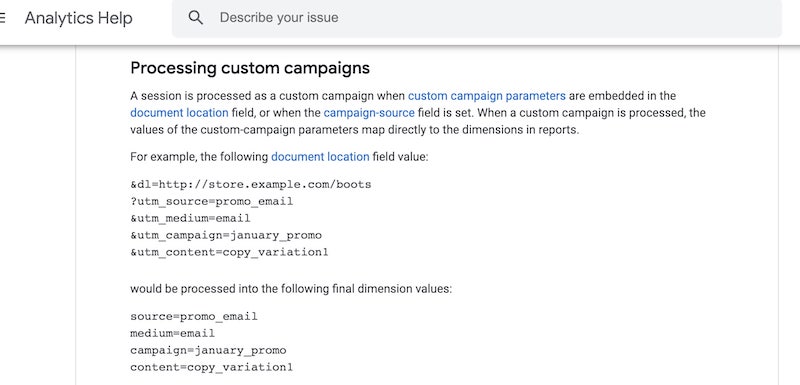
Above is a preview. Let’s explore the details of creating UTM parameters.
How to create UTM Parameters
Though UTM Codes sound technical, they are simple to use and create. You don’t need a high-end development team or group of coders to create usable UTM code.
You can create UTM parameters manually or generate them with the help of a tool.
Create UTM Codes Manually
Creating UTM parameters by hand is easy. The formula is:
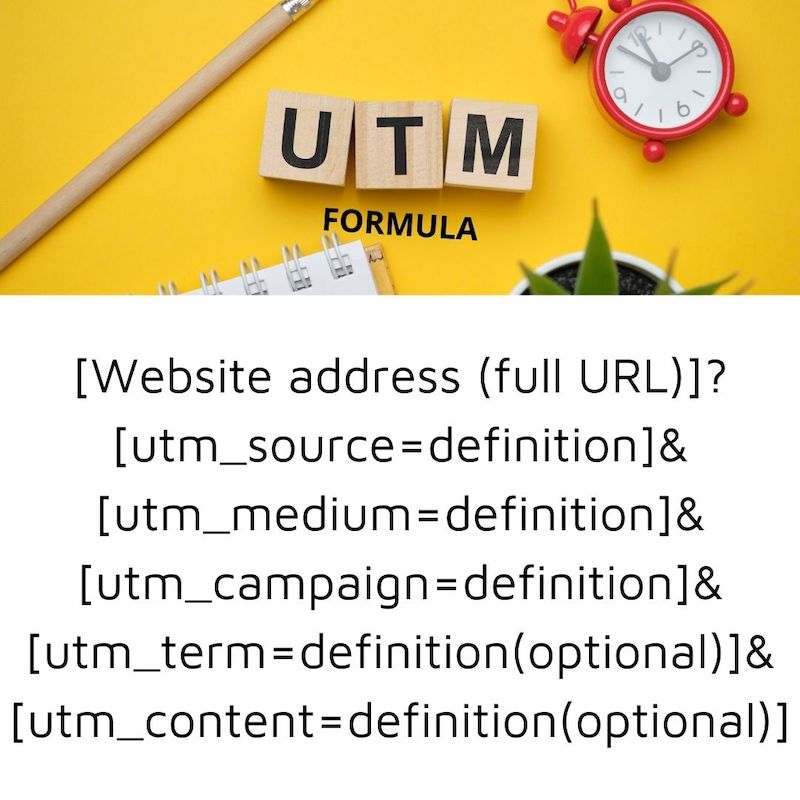
The brackets fall off in the official UTM parameter and place the UTM elements at the end of the URL.
A complete link would look like this:
Simple, right?
Unfortunately, simple doesn’t mean convenient.
It is critical that your UTM parameters are free of errors. As you see with the example above, that could be quite a challenge.
Imagine if you had to create 100s of these manually?
Don’t worry, someone knows how valuable your time is and has created UTM generator tools and tracking URL builders.
UTM Parameters Builder – Generation Tools
Generation tools create error-free UTM parameters quickly. You can also use them to manage your created UTM parameters.
The most used is Google Campaign URL Builder.
Google Analytics Campaigns URL Builder
This is Google’s UTM generator. It’s simple to use, just follow these steps:
- Go to Google Analytics Campaign URL Builder. You will see the following panel:
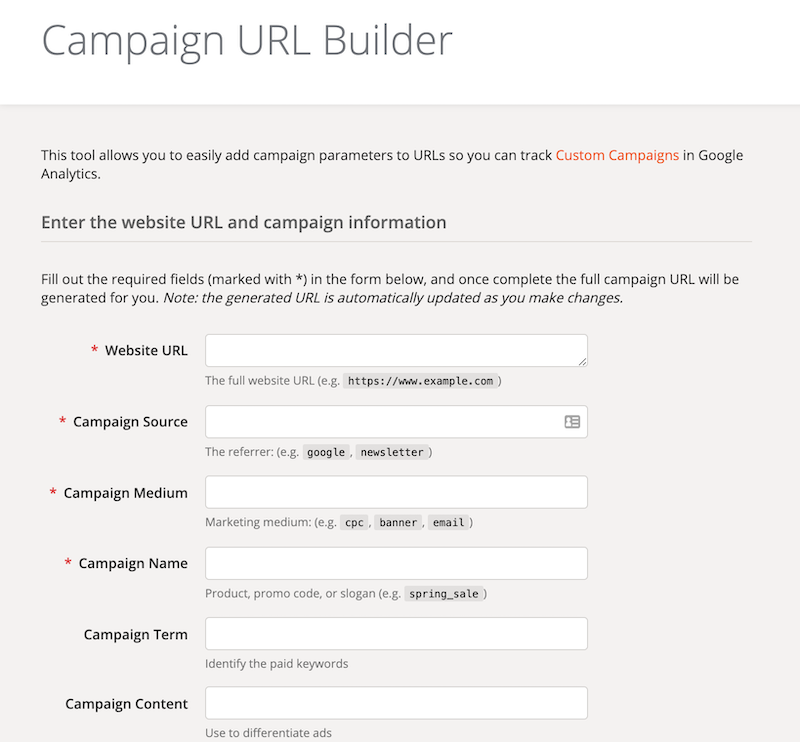
- Enter the values using the criteria and suggestions described above.
- Scroll down and click Convert URL to Short Link.
Other UTM parameter generation tools available include:
- UTM.io. An online tool that builds, shares, and syncs UTM codes.
- Terminus. This is a great tool for the organization of UTMs. It enforces your naming preferences and manages your UTM parameters.
Now that we know what UTM parameters are, their importance, and how you can create them, let’s examine how Google understands them.
How Google Understands Traffic Sources
To really understand how UTM parameters work, we must break down how Google processes traffic sources.
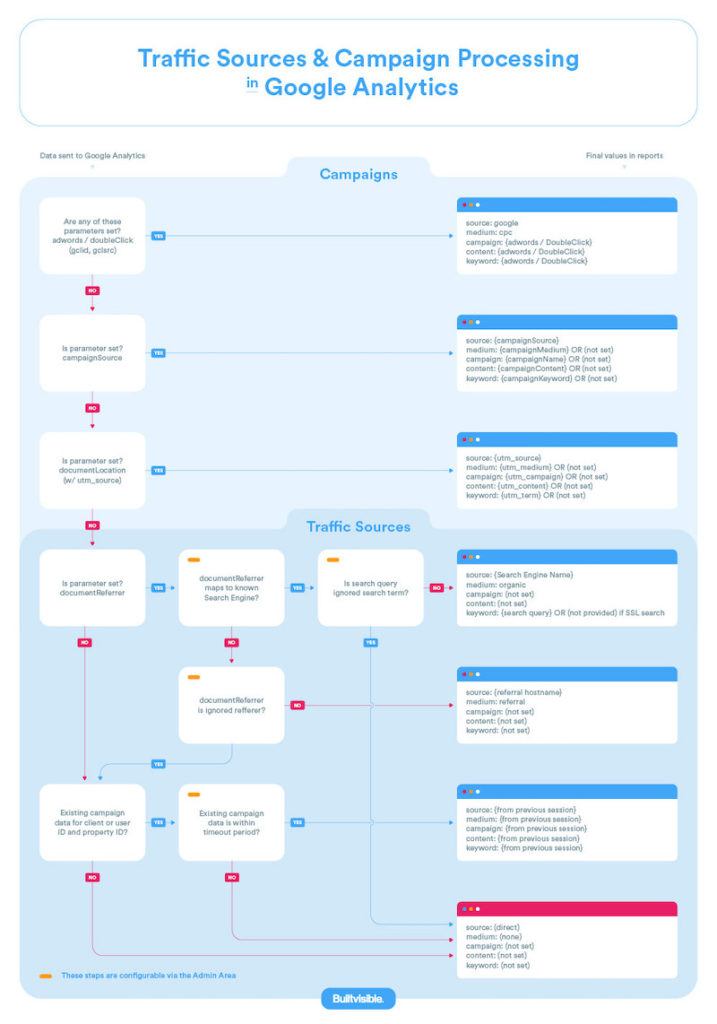
For each session in Google Analytics, one traffic source is identified.
Google Analytics support defines a session as:
“A session is a group of user interactions with your website that take place within a given time frame. For example, a single session can contain multiple page views, events, social interactions, and e-commerce transactions.”
You can think of a session as the container for the actions a user takes on your site.”
As mentioned above, a session can only have one traffic source. Google Analytics processes traffic sources using two elements:
- HTTP Referrer
- UTM Parameters
You already know what UTM parameters are and their benefits, so let’s examine HTTP Referrer.
What is HTTP Referer
Geek-to-Geek defines HTTP Referer as,
“a request-type header that identifies the address of the previous web page, which is linked to the current web page or resource being requested. The usage of this header increases the risk of privacy and security breaches on a website but it allows websites and web servers to identify where the traffic is coming from. The Referer can not be sent by the browsers if the resource is the local file or data.”
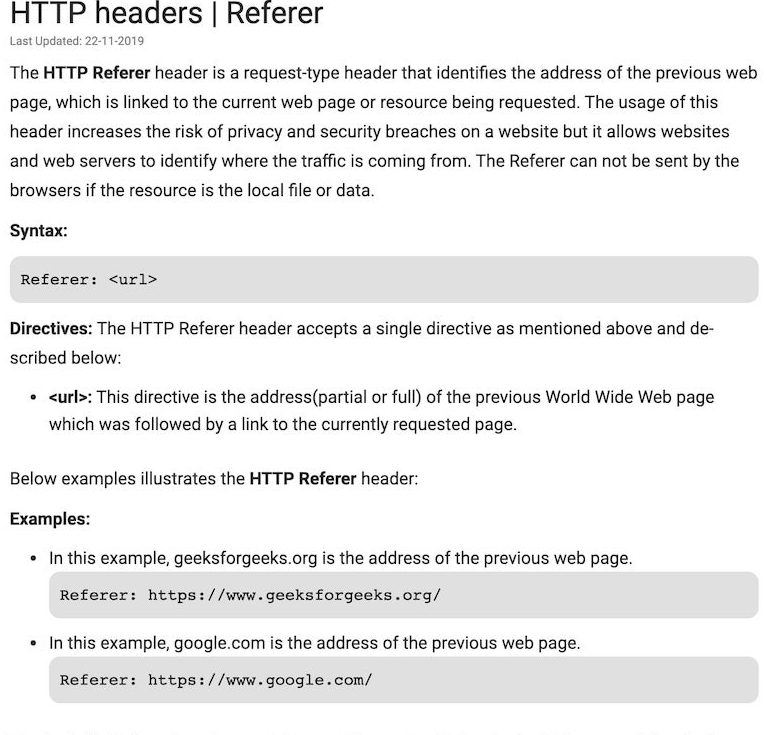
Going back to our example of your Wiggie Doodle-1000. When someone clicks on the link of one of your promoters (Page A) they are taken to a landing page for Wiggie Doodle-1000 (Page B).
Where:
The header “HTTP Referrer” passes the URL of the referring page to the destination page.
Google Analytics can read this information using scripts like Google Tags, LinkedIn pixels, etc., which are installed on destination pages. Google Analytics uses the destinations determined by the HTTP Referrer as the referring website as the source of that session.
Most of the time the HTTP Referrer value is available for Google to reference. But there are a few cases when it’s not, making it impossible to understand the true source of your traffic.
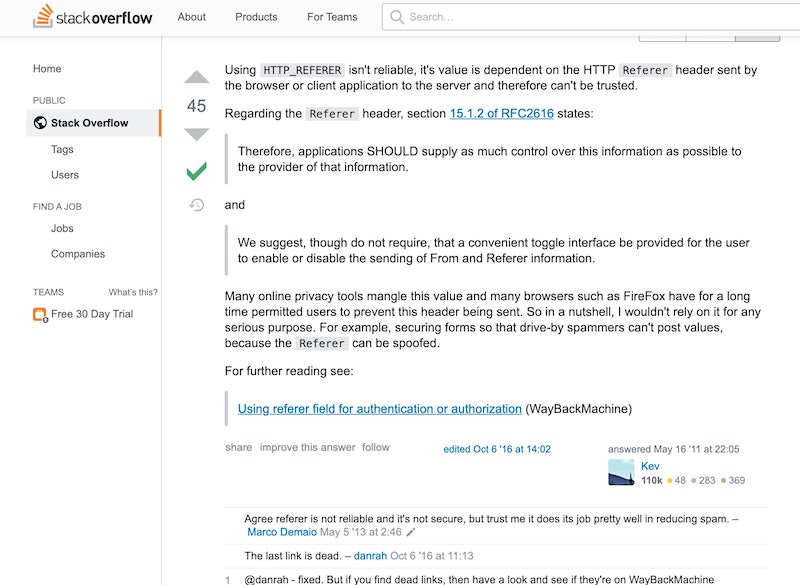
Reasons HTTP Referrer Fails:
- Direct traffic that comes from URL entered directly into a browser or clicked from a bookmark.
- Traffic that comes from scanned QR codes.
- Links clicked in mobile apps
- To maintain security, when visitors travel from HTTPS pages to a page without security HTTP, Google will not transfer referrer data.
- When traffic comes from linked in a tool or doc, like a PDF or Google document.
Using UTM parameters allows the link to “self-define” its source. Making it a reliable method that ensures source data is captured even with the HTTP Referrer value fails.
Where both HTTP Referer and UTM parameters values are empty, Google Analytics does not understand the exact traffic source puts the generic classification of ‘Direct’ on it.
So you can see why UTM parameters are so important to have.
Even when HTTP Referer performs perfectly, it only gives you one piece of data, the source.
Where UTM Parameters give you a full picture, providing the data necessary to analyze your marketing efforts.
Using UTM Parameter
Benefiting from UTM Parameter begins with the step-up. Following are four steps to get you up and running quickly.
Google Analytics is the tool that collects the data your UTM collects. As a CRO expert you probably already have Google Analytics Tracking ID installed on your website.
However, if you don’t, you will need it to use the UTM Parameters you created.
Here are the steps to set up Google Analytics so you can analyze data collected using your UTM parameters:
Step 1: Set up Google Analytics
- Sign in to Google Analytics (if you don’t have an account already, create one).
- Add your website as a property.
- Click Tracking ID, your tracking ID will appear.
- Follow the instructions Google Analytics provides to copy and paste the global site tag on your site. It should go right after the <head> tag in your HTML Code.
Step 2: Add UTM parameters
Add your UTM Parameters to your campaign. Use your preferred method of UTM parameter generation to create links that will feed data in Google Analytics.
Once created these parameters can be distributed for your campaign.
Step 3: Use UTM parameters to track your campaigns
- Log into your Google Analytics account.
- Click Reports ⇒ go to Acquisition ⇒ then click Campaigns.
- Take a look at your numbers.
Step 4: Analyze data gathered from your UTM parameters
Data is only as good as the analysis of it. Once you understand the information come up with an action plan to optimize what’s working.
Conducting A/B Test Using UTM Parameters
Since UTM parameters can provide information about the variant clicked in an A/B test (aka split testing), it is helpful to use them in your experimentation program.
Marketing and experimentation go hand and hand.
Split testing allows you to come up with hypotheses about your marketing strategy and then test those ideas on your audience using data-driven measurements.
For example, you may have two landing pages for your Wiggie Doodle-1000. You think one will convert higher than the other one. But without testing, this is only a guess.
Google’s Urchin support suggests the using the following values with your A/B test.
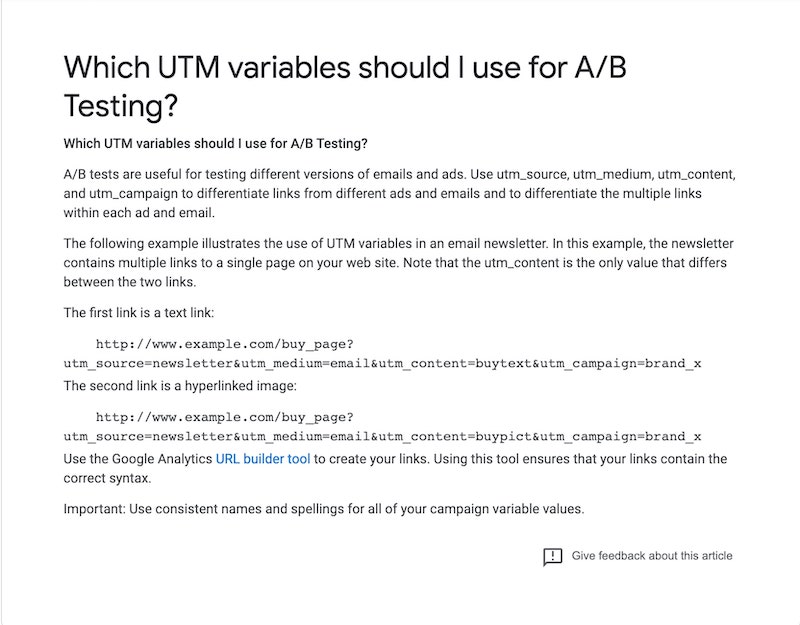
They also explain how to perform A/B Testing using UTM parameters.
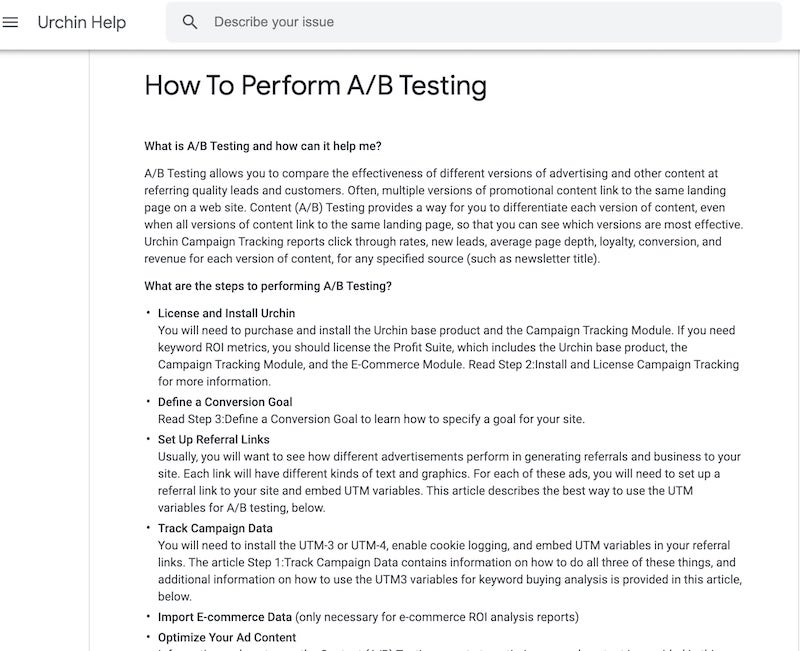
Of course you can also use a tool like Convert to handle your split testing needs. Using UTM parameters with robust testing tools allows you to add dimensions to your A/B Test reports.
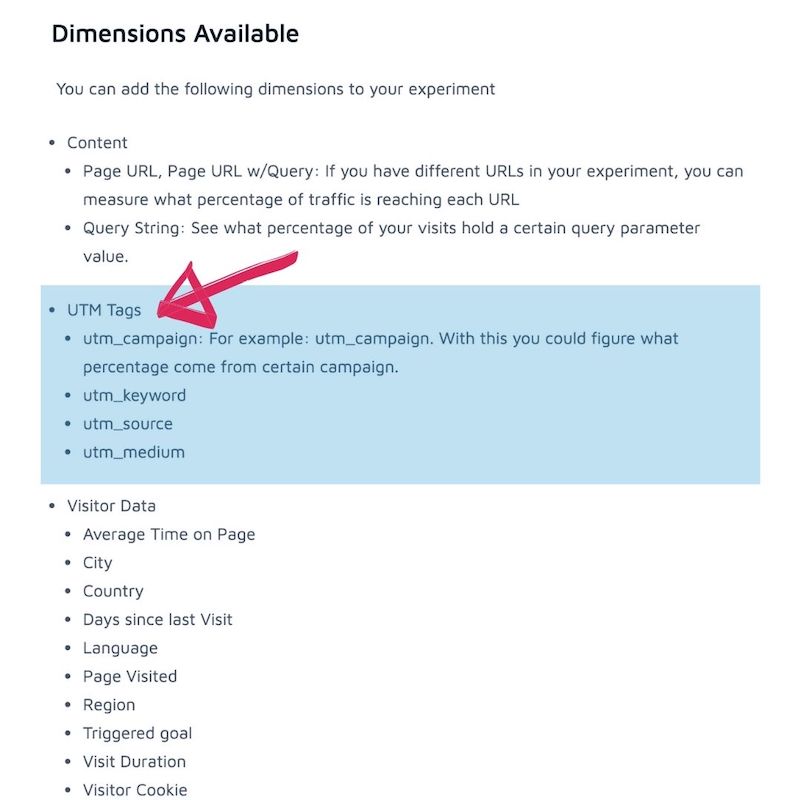
Tips for Using UTM Parameter (Best Practices)
UTM parameters can change the landscape of your optimization and marketing, but only if you implement them right. Here are a few UTM parameters best practices worth following for success.
Don’t use UTM Parameters for Internal Linking
When a UTM parameter is used as an internal link, your Google Analytics data is compromised. Google handles those clicks as new sessions, which overrides the true source. Thus, you don’t see an accurate picture of your customer’s journey around your website.
Be Careful What information You Put In Your UTM Parameters
Remember, your URL appended with UTM parameters is visible, so be mindful.
Ideally, you want to hide your UTM parameters completely from visitors. Wistia has a cool tool that lets you hide your UTM parameters from the browser bar while maintaining all the data collected in Google Analytics. It is called Fresh URL.
Keep up with multiple UTM Tags – Stay Organized
If you run multiple campaigns across different channels, it is easy to mistrack your UTM parameters. The list of UTM codes can snowball. To avoid this, use UTM Tracking Tools to keep your UTMs organized. This can be as simple as a spreadsheet or as complex as software.
Organization also includes creating and sticking to a naming convention. If you have a team, this will be especially valuable.
Document your naming convention. You don’t have to go so far as creating a complete UTM styling guide. But if you did, it wouldn’t be going overboard.
Suggestions include:
Uppercase or Lowercase – Choose One
For instance, all uppercase or all lowercase. As stated early, UTM are case sensitive, so, utm_campaign=CONVERT, utm_campaign=Convert, and utm_campaign=convert are all different.
Don’t use Punctuations or Special Characters within Elements
Use a question mark after the URL and your first UTM parameter.
Stay Away from the Space Bar
White spaces in your UTM are an easy source of error.
No Duplication
Don’t duplicate URLs with UTM Parameters. Not only can you get erroneous data, its confusing to manage.
Shorten Long UTM parameter Links
Turn long ugly links that contain UTM parameters into short manageable ones. You can use a URL shortener tool like bit.ly.
Test Your UTM Parameter
Check your UTM Parameter before placing it in circulation. You want to ensure it works. Your data will be meaningless if it doesn’t work.
For an extra dose of control, you can create filters in Google Analytics that will transform UTM in the wrong “standardize formation” to the correct form for consistency.
Wrapping it up…
You now know more about UTM than 99% of marketers and CROs.
Hopefully, this article has inspired you to use UTM parameters for all your inbound links. The benefits are not only clarity regarding your customer journey but also accuracy in the collection of traffic attribution data and an increase in ROI with your data analysis which might reduce campaign spend (or increase campaign spend for greater returns).
But remember to watch out for the pitfalls and take heed to the tips. UTM parameters can quickly spin out of control, becoming chaotic and stripping them of all their usefulness.
Do you have any insights or unique ways to use UTM parameters in your marketing?


